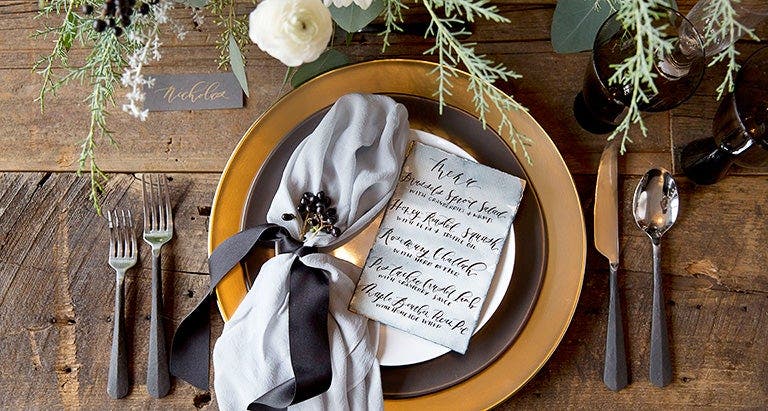Wedding Lingo Decoded
Learn the language of the wedding industry to help ease the stress of planning your wedding.
Published January 6, 2018


Organizing a wedding is confusing enough. Then throw in all the say-what-again? terms used by your florist, caterer, and planner and you just might wonder if you’ve stepped into a foreign country. Instead of feeling lost as you plan your way down the aisle, rely on this handy guide to chart your course. (Definitions provided by Alexandra Hamilton, owner and lead designer of Willow & Ivy Events in Seattle.)
Decoding the baker
- Buttercream: The kind of icing you typically associate with birthday cake. It’s not satiny smooth, but it has a lot more flavor than fondant (see next).
- Fondant: Hard icing put over a wedding cake to give it a smooth, seamless look. The downside: Fondant isn’t very tasty. You’ll often find regular icing underneath it to add flavor.
- Ganache: This chocolate glaze or sauce might be found between the layers of your cake.
Decoding the caterer
- Charger: Large decorative plates that go under your dinner plates, chargers give your tables a prettier overall look. They are just for aesthetics, and typically are taken away when dinner is served.
- Escort cards versus place cards: Escort cards are often laid out on a table near the entrance of the reception. They tell guests which table they should sit at for dinner, and might include meal choices. (This information can also be written on a mirror or some other creative material, in which case it’s called an escort display.) Place cards are put on the actual table and tell guests they have an assigned seat. You don’t need to have place cards—when you don’t, guests just sit wherever they’d like at their assigned table.
- Head table versus sweetheart table: A sweetheart table is just for the bride and the groom, while a head table is for the bride, groom, and entire wedding party.
- Place setting: What each guest will have in front of them when they sit down for dinner. It includes things like plates, silverware, and glasses.
- Tablescape: A term for the entire look of your tables, which may include floral centerpieces, candles, place settings, place cards, tablecloths, and other linens.
Decoding the dressmaker
- Bustle: This is a way to pull the train of the dress up so that the bride can move around without tripping. American bustles are pulled up and hooked on the outside of the back of the dress, while French bustles get hooked underneath the dress.
- Fascinator: Instead of a veil, some brides wear this little headpiece that sits slightly to one side of their hairdo.
Decoding the florist
- Boutonniere and corsage: These are both small flower arrangements worn by members of the wedding party. Boutonnieres are worn by the groom, groomsmen, ushers, and dads on the lapel of their jackets. Corsages are usually a bit bigger and are donned by moms, aunts, and other female relatives; they can be pinned to dresses or worn on wrists.
- Nosegay: This small bouquet or tiny floral arrangement is given to the mothers of the bride and groom before the ceremony for them to carry when they walk down the aisle. It’s used instead of a corsage.
- Pomander: These are little balls of flowers that can be hung on the chairs edging the aisle—or held by a flower girl instead of a basket of petals. They are typically suspended from a ribbon.
Decoding the photographer
- First look: A photograph taken before the ceremony when the bride and groom meet for the first time that day. One common way to stage the shot is for the groom to have his back to the bride and then turn around and see her (nobody else is usually around). It’s a good way for the bride and groom to be photographed together before the ceremony so they don’t have to take as many pictures afterwards.
- Digital rights: When deciding on a package with your photographer, find out if you’ll have full digital rights to all the images. This means you are purchasing the electronic files and can download, print, and share as many as you want.
Decoding the planner
- Day-of coordinator versus wedding planner: A day-of coordinator helps manage vendors, creates a timeline, and does anything else needed to make sure your day goes off without a hitch. A wedding planner does all that as well, but also gets involved at the beginning of the process to help pick vendors, come up with designs, and make sure everything comes together perfectly.
Decoding the stationer
- Card stock: Invitations aren’t typically printed on thin, flimsy paper. Instead, they are printed on card stock, which is thicker and more luxurious feeling.
- Embossing versus letterpress: These are both printing methods that give your invitations a texture that goes beyond flat print. Embossing raises type up off the paper (you can feel the text when you run your hand over it). The letterpress method sinks the printed material down into the paper.
- Invitation suite: The collection of stationery items you order to go with your invitations. It can include the actual invite, an RSVP card, an envelope for the RSVP card, and possibly an extra information card that tells guests which hotels have room blocks, where they can park, or if there’s a brunch the day after the wedding.
